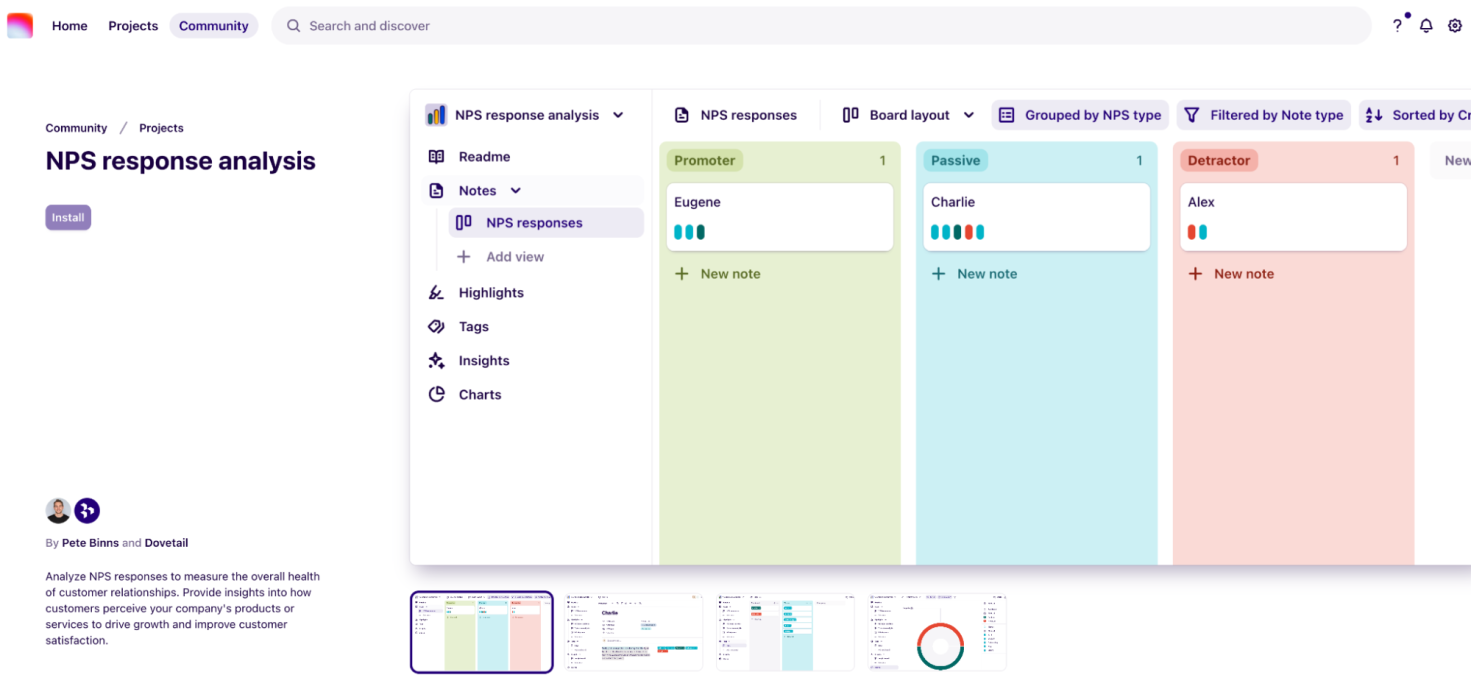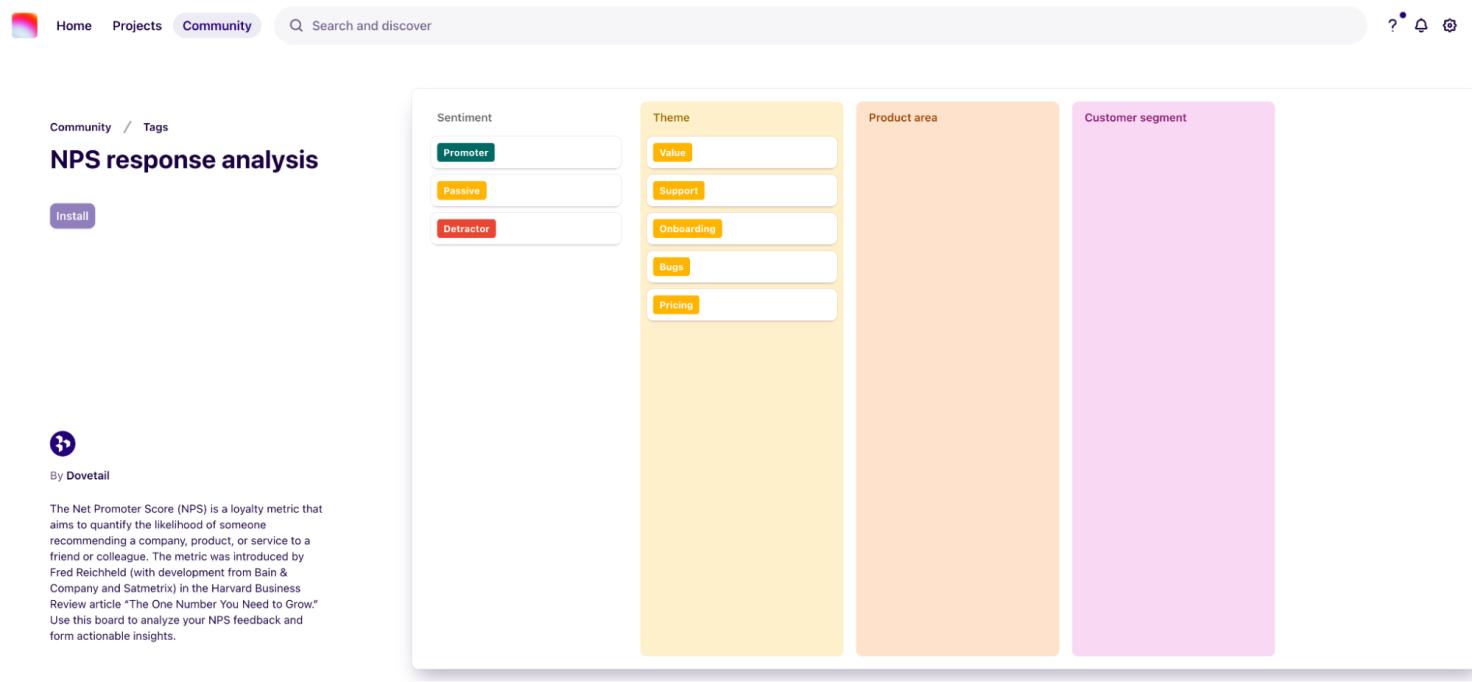Best NPS survey and NPS analysis templates
Last updated
25 March 2023
Reviewed by
Working in a large organization with over 100+ employees? Discover how Dovetail can scale your ability to keep the customer at the center of every decision. Contact sales.
Today's marketing landscape gives every company, big and small, a voice to attract consumers' attention.
In such a competitive landscape, customer satisfaction is the best way to ensure your customers remain loyal.
After all, happy customers make more purchases and can even act as ambassadors for your brand.
So, how can you ensure your products and services continually delight customers?
Net promoter score (NPS) surveys use a rating scale to determine customer satisfaction.
They can even include follow-up questions to explain why you're meeting (or failing to meet) your customers' needs.
By learning more about NPS surveys, you can develop questions that help you gain an accurate understanding of how consumers perceive your company, product, or service.
Here are some tips and templates to get you started.
NPS calculator
Your Net Promoter Score is calculated by subtracting the percentage of Detractors from the percentage of Promoters.
0
NPS score
Detractors
0Passives
7Promoters
90
NPS score
What is a net promoter score survey?
An NPS survey is a simple questionnaire that measures how likely a customer is to make a repeat purchase or recommend your brand or products. It is generally a two-part survey consisting of quantitative and qualitative feedback.
The first question asks respondents to give a rating between 0 and 10 on how happy they are with your product, service, or customer experience. Then, the follow-up question is open-ended and designed to uncover the "why" behind the rating.
For example, you may begin by asking, "How likely are you to recommend (Brand) to a friend or colleague?" The customer would then choose the score that reflects the satisfaction level with their experience.
The follow-up question will provide more information about why they gave the score. It can be as vague as "What's the main reason you would (or wouldn't) recommend us?" or more detailed, like, "What did you like or dislike about the product?" This question gives you qualitative information you can use to improve your products and services.
How to develop NPS questions
Versatility is one of the biggest benefits of NPS surveys. You can use them to track overall satisfaction, but you can also adapt questions slightly to track satisfaction with specific products, customer service, and even features of new or evolving products and services.
Carefully consider your goals when choosing what to add or omit from your survey. You will gather actionable customer feedback if you precisely formulate a question around those goals.
While NPS surveys should be easy for both the user and the customer, vague or basic questions might fail to give you the results you're after. It's essential to consider the wording of your questions.
The referral question in the example above is useful for measuring overall satisfaction. However, if you're concerned about customer churn, getting right to the point with the follow-up question will likely provide more results than simply asking for the reason behind the score.
For example, ask, "What could we have done differently to improve your experience?"
While it may seem dangerous to ask customers to think negatively about your service, the answers to such a question offer valuable feedback you can use to improve.
Types of NPS survey questions
Customer experience feedback should provide broad and more granular details explaining the data. Passive ratings that suggest a customer thinks your brand is "okay" don't provide insight into what you're doing right or wrong. Two main types of NPS survey questions help you uncover specific information about customer satisfaction levels.
Relational NPS: This score provides a broad outlook of how customers feel about their relationship with your company over a period of time. It's the most common NPS survey and is usually repeated regularly. Relational NPS surveys are typically used for benchmarking and tracking customer satisfaction over time.
Transactional NPS: While this survey type also tracks customer satisfaction, it asks for more details about specific transactions. You might conduct Transactional NPS surveys after a customer purchases a new product, interacts with customer service, or uses a new website feature. The rating question directly relates to a specific transaction and allows the customer to provide detailed data about what they liked or didn't like during the experience. If the result is positive, you can gain clarity about the value of a new product or service. If it's negative, you can quickly pinpoint where issues arise.
Considering your goals is imperative for getting qualitative data to help you improve or maintain customer satisfaction levels. However, you don't have to come up with perfect questions independently. Many resources are available to help businesses generate NPS survey questions aimed at both customers and employees. NPS survey question templates are one of the most effective tools for developing highly effective NPS survey questions.
NPS survey question templates
Templates can provide you with sample questions to help develop your survey, but you can also customize the templates to reflect your goals. There are three main types of NPS survey question templates. The type you choose will be related to the level of detail you hope to gather.
Basic NPS survey form
This form is the most common and one you've likely seen before. It begins with a basic question with a 1-10 rating. When the user chooses a rating lower than 6, another field opens automatically to help clarify the score. You can customize the question to ask about overall satisfaction with your brand or satisfaction with a specific product or service. Since the follow-up question intends to assist with developing improvements, it will directly relate to what features or services disappointed the customer.
Enhanced NPS survey form
If you want to gather more details, you can use an enhanced survey form to customize follow-up questions based on the rating you receive. The enhanced survey form begins by asking for a rating. The follow-up questions are provided to all survey-takers but align with the rating provided. So, low scorers will get a question asking what disappointed them, and high scorers will get a question asking what they like most. A third question can follow, asking high scorers if they'll provide a testimonial and low scorers if they'd like to share more information about their experience.
Simple survey form with NPS field
This form is designed for simplicity and eliminates the follow-up question. It provides an average NPS score which helps see where you stand currently and over time (benchmarking). You can also use it for advertising a high NPS rating.
NPS survey analysis
An NPS survey lets your customers know you care about their opinions. However, it's only useful if you implement the feedback by improving or refining your products and services.
Analyzing the results of your NPS survey will help you determine the actions you need to take moving forward.
Begin by calculating your net promoter score.
NPS survey results allow you to divide respondents into three categories based on the 11-point system
Promoters: Respondents with a score of 9 or 10
Passives: Respondents with a score of 7 or 8
Detractors: Respondents with a score between 0–6
After dividing categories into groups, calculate your net promoter score by subtracting the percentage of detractors from the percentage of promoters.
Once you calculate your NPS, you can categorize it as bad, acceptable, good, or excellent and benchmark it against your previous score.
Using NPS survey analysis templates for enhanced analysis
Responses to the open-ended follow-up question include responses from all three categories and offer a wealth of qualitative data. They also require considerably more effort to analyze. To accurately digest all the information from follow-up comments, you must categorize them into themes.
Manually categorizing comments will likely require multiple spreadsheets and a significant amount of time. So, using a survey analysis template will expedite the process and improve the clarity of your results.
A template can be a kanban board that allows you to tag NPS responses and identify themes and patterns quickly.

If you're seeking a more detailed analysis, you can choose a template that will enable you to create and distribute an NPS survey, then conduct an in-depth analysis of the responses provided.

Making the most of your NPS Surveys
A net promoter score alone offers little value beyond providing a direct percentage of how survey-takers perceive your brand, products, or services. The follow-up question is where actionable data comes into play to provide information that can help you make improvements to change and grow your business. The proper templates can make developing and analyzing NPS survey questions a simple process that can be conducted routinely to benchmark improvement and maintain and improve customer satisfaction.
Should you be using a customer insights hub?
Do you want to discover previous customer research faster?
Do you share your customer research findings with others?
Do you analyze customer research data?
Editor’s picks
Last updated: 16 October 2024
Last updated: 22 February 2024
Last updated: 12 May 2025
Last updated: 11 May 2025
Last updated: 11 May 2025
Last updated: 13 May 2024
Last updated: 16 February 2025
Last updated: 4 July 2024
Last updated: 2 December 2024
Last updated: 11 May 2025
Last updated: 11 May 2025
Last updated: 22 April 2025
Last updated: 13 May 2024
Last updated: 19 May 2025
Last updated: 11 May 2025
Latest articles
Last updated: 19 May 2025
Last updated: 12 May 2025
Last updated: 11 May 2025
Last updated: 11 May 2025
Last updated: 11 May 2025
Last updated: 11 May 2025
Last updated: 11 May 2025
Last updated: 22 April 2025
Last updated: 16 February 2025
Last updated: 2 December 2024
Last updated: 16 October 2024
Last updated: 4 July 2024
Last updated: 13 May 2024
Last updated: 13 May 2024
Last updated: 22 February 2024